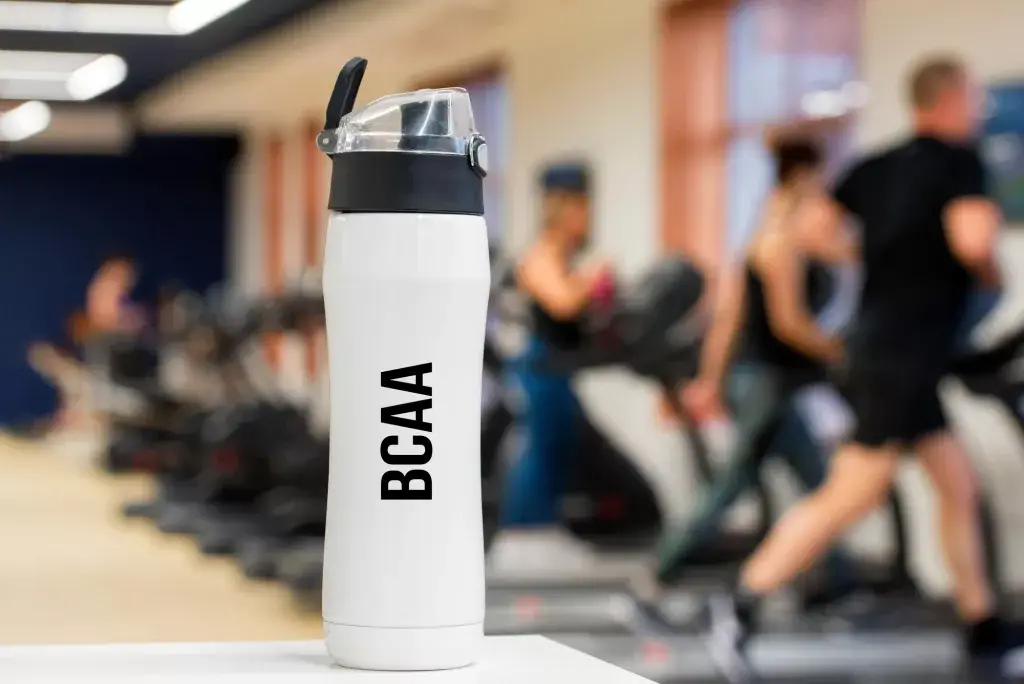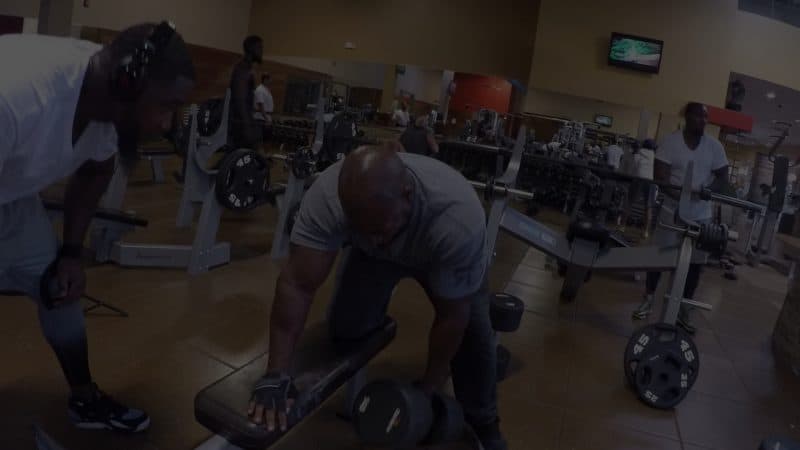What’s a winning physique? It’s surely not a dude with bulging shoulders and pecs strutting around on chicken legs. Look, a lot of guys avoid leg day, but you’re doing yourself a disservice. Stop running away. Smash your goals.
Here’s exercises that are proven to help you get massive gains that are also safe and smart. Let’s check them out.
How To Work The Legs
Before we get into the exercises, though, let’s get a general understanding of working the lower body. You need proper form. Work on proper form first, and you will have better results from the beginning. Lastly, don’t focus too much on higher repetitions. Work within the 80-85% 1RM range for the most growth.
Recommended Leg Exercises For Growth
With some basic information out of the way, it’s time to introduce the exercises.
Barbell Back Squat
Note: Best performed inside a rack for safety.
3-4 sets x 8-10 reps
Rest: 3 minutes
How to do:
Start with your feet under the bar, hands in position. Get under the bar. Adjust your grip if you need to. Keep the chest up and the elbows down. Squat up to unrack the bar and keep your core engaged, back long. As you continue to perform a rep, keep your heels under your shoulders with the toes out on a slight diagonal. Get your backside as low to the ground as comfortable for your joints. To get up from the squat, drive through glute and hamstring muscles, squeezing and pressing.
Barbell Front Squat
3-4 sets x 8-10 reps
Rest: 3 minutes
How to do: Bring your arms up under the bar. Keep the elbows high, upper arms parallel to the floor. The bar should rest atop the deltoids when your arms are crossed. From there, lift the bar from the rack by pushing with your legs up and keeping the torso straight.
Step away from the rack and take a squat position—feet under shoulders, toes pointed outward. This is the starting position.
Lower down slowly. Maintain a straight posture as the knees bend. Eventually, the thighs should be below parallel with the floor. As you start to lift from the bottom position, exhale and push the floor through the middle of the foot while engaging the quads.
Repeat.
Barbell Lunge
3-4 sets x 8-10 reps on both sides
Rest: 3 minutes
How to do: Once you have unracked the bar, step forward with either your right or left leg. Maintain balance and squat down. Think about lowering the hips, not bending the knees in order to keep your form. The torso remains straight. Knees bend to 90-degrees. Don’t allow the front knee to go beyond the toes. Once you reach the lowest point, power back up through the feet. Repeat this movement 9 more times on one leg then switch.
Leg Press Machine
3-4 sets x 8-10 reps
Rest: 3 minutes
How to do: Start by sitting at the machine with your back firm against the seat. Your feet are flat on the foot plate, slightly wider than hip-width apart. Grab the handles on either side of the seat. From there, push the plate away by extending through the knees and hips. Turn the locking safety handle so you can move freely. Then, keep pushing through the feet until you’re extended. Bring the plate back slowly. Never fully lock the knees as your work. Repeat the motion.
Leg Curl Machine
3-4 sets x 8-10 reps
Rest: 3 minutes
How to do: Once you’ve readied the machine for use, place the back of the lower leg on the padded lever. Second the lap pad against your quads, above the knees. Grasp the side handles. Make sure you start with the legs fully straight out behind you. Now, exhale, pulling the machine lever back as you bend the knees and lift your heels towards your back. Hold the contraction for a second. Slowly lower back to starting position. Repeat.
Standing Calf Raise
3 sets x 8-10 reps
Rest: 3 minutes
How to do: [Use dumbbells or the machine] On a workout step or platform, stand with your feet under your shoulders. The balls of your feet are on the top half of the platform/step, and the heels are hanging off. Push up, extend the knees, and keep the torso erect. Never lock the knees as you rise. Continue raising the heels as you breathe then lower slowly to starting position, feeling the calf release and stretch. Repeat.
Romanian Deadlift
3-4 sets x 8-10 reps
Rest: 3 minutes
How to do: Hold a bar at hip level with palms facing down. Shoulders are back, the back is arched, and the knees are slightly bent. This is where you start. From there, lower the bar down by moving the butt back. Keep the bar close to the body as you move. When done correctly, the maximum range is just below the knee. At the bottom position, squeeze through the back body and drive the hips forward to return to standing. Repeat.
That’s it! You don’t need anything else—just consistency and determination.
You can’t spell legendary without “leg day.” With these exercises, you can grow your legs and get that bodybuilding physique and strength you’ve been working hard to achieve.
Enjoyed this article? For more tips and tricks and information on how to train effectively, check out my YouTube channel and hit that subscribe button.
You Might also like
-
Mastering the Ride: How to Prevent and Treat Common Sportbike Injuries
The exhilarating rush of leaning into a corner, the wind whipping through your hair, and the undeniable thrill of commanding a powerful machine – these are just a few of the reasons why sportbikes hold such a special place in the hearts of many riders. However, with the incredible performance and sharp handling of these motorcycles comes a heightened degree of risk for injuries.
This article delves into the world of sportbike injuries, equipping you with the knowledge and practical steps to navigate the journey safely. We’ll explore the most common injuries associated with sportbike riding, delve into preventative strategies, and shed light on treatment options. By understanding the risks and taking necessary precautions, you can continue to enjoy the thrill of the ride while minimizing the chances of encountering these injuries.
Key Takeaways:
- Common sportbike injuries include wrist/hand, shoulder, neck/back, and leg/foot injuries.
- Prevent injuries through proper gear, ergonomic bike setup, strengthening exercises, and safe riding practices.
- Seek immediate medical attention for any suspected injury.
- Treatment options include rest, pain management, physical therapy, and surgery (if needed).
- Prioritize safety by learning continuously, maintaining your bike, and riding with responsible individuals.
Comparison Table: Common Sportbike Injuries vs. Preventative Measures
Injury Preventative Measures Wrist and Hand Sprains/Fractures Wear protective gloves, maintain proper grip on handlebars, avoid over-torquing controls. Shoulder Strains/Dislocations Strengthen core and shoulders, maintain upright posture, avoid locking elbows. Neck and Back Pain/Herniated Discs Maintain neutral posture, avoid hunching, strengthen core muscles, take regular breaks on long rides. Leg and Foot Sprains/Fractures Wear sturdy motorcycle boots, maintain proper footpeg placement, avoid excessive shifting or braking. Comparison Table: Common Sportbike Injuries vs. Preventative Measures
The Landscape of Sportbike Injuries: Understanding Common Risks
The unique design and riding style of sportbikes expose riders to specific physical demands and potential hazards. Let’s delve into the most prevalent forms of injuries encountered by sportbike enthusiasts:
1. Upper Body Injuries:
-
Wrist and Hand: The aggressive riding position, coupled with the potential for falls, makes these areas particularly vulnerable. Common injuries include sprains, fractures, and carpal tunnel syndrome, caused by repetitive strain on the nerves and tendons.
-
Shoulder: Similar to wrist and hand injuries, the shoulders bear the brunt of the forward-leaning posture and potential impact in a fall. Dislocations, strains, and rotator cuff injuries are common occurrences.
-
Neck and Back: Long rides with a hunched posture can put immense strain on these areas, leading to pain, stiffness, and even herniated discs. Improper core engagement further exacerbates the situation.
2. Lower Body Injuries:
- Leg and Foot: While less frequent than upper body injuries, leg and foot injuries can happen in accidents or due to repetitive motions while shifting and braking. These can include ankle sprains, fractures, and nerve damage, causing pain and limiting mobility.
3. Additional Injuries:
- Head Injuries: Although mitigated by wearing a helmet, head injuries can still occur in severe accidents, highlighting the importance of choosing and using a DOT-approved helmet consistently.
4. Psychological Trauma:
- Accidents, even minor ones, can cause emotional distress and even post-traumatic stress disorder (PTSD) in some individuals. Seeking professional help is crucial if you experience emotional difficulties after an accident.
Safeguarding the Ride: Proven Strategies for Injury Prevention
Knowing the risks is essential, but the true power lies in taking proactive steps to prevent them. Here are some key strategies you can implement:
1. Gear Up for Protection:
- Helmet: Invest in a high-quality, DOT-approved helmet that fits snugly but comfortably. Replace it every five years or after any significant impact.
- Protective Clothing: Opt for abrasion-resistant leather or heavy textile gear that covers your entire body. Leather offers superior protection but can be warmer in hot weather.
- Footwear: Wear sturdy motorcycle boots that provide ankle support and good grip on the footpegs.
2. Ergonomics Matter:
- Bike Fit: Ensure your bike is adjusted to your specific body measurements. This includes proper handlebar height, seat position, and footpeg placement. An ergonomically correct setup reduces strain on your body and allows for better control.
- Maintaining Posture: Maintain a neutral, upright posture while riding. Avoid hunching your back or locking your elbows, as this can lead to fatigue and increase the risk of injury.
3. Strengthen Your Body:
- Targeted Exercises: Regularly strengthening your core, back, and shoulders improves your riding posture and endurance. This enhances control and reduces the risk of fatigue-induced errors.
- Stretching: Don’t underestimate the power of stretching. Regularly stretching improves flexibility and range of motion, reducing the risk of strains and muscle fatigue.
4. Master Your Skills:
- Safety Courses: Enroll in a motorcycle safety course to learn proper braking, cornering, and maneuvering techniques. These courses hone your skills and equip you with the knowledge to handle challenging situations safely.
- Practice Makes Perfect: Regularly practicing in a controlled environment builds confidence and refines your skills, allowing you to react calmly and effectively in real-world situations.
5. Listen to Your Body and the Road:
- Fatigue Factor: Avoid riding when you’re tired or under the influence of alcohol or drugs. Fatigue impairs judgment and reflexes, significantly increasing the risk of accidents.
- Stay Alert: Be mindful of your surroundings and anticipate potential hazards. Watch out for other vehicles, road conditions, and weather changes.
- Take Breaks: Schedule regular breaks on long rides. Get off the bike, stretch your legs, and rehydrate to prevent fatigue and maintain focus.
Navigating Recovery: Treatment Options for Sportbike Injuries
Despite taking all necessary precautions, accidents can still occur. If you sustain an injury while riding, immediate medical attention is crucial. A qualified healthcare professional can accurately diagnose the severity of the injury and recommend the most appropriate treatment course.
Here’s a glimpse into some common treatment options for sportbike injuries:
1. Rest and Immobilization:
- Depending on the nature and severity of the injury, the doctor might recommend rest and immobilization. This allows your body time to heal and prevents further damage. Immobilization may involve casts, splints, or slings.
2. Pain Management:
- Managing pain is essential for promoting healing and comfort. This may involve medication like pain relievers, anti-inflammatory drugs, or muscle relaxants. Topical pain relief options like creams and gels may also be used.
3. Physical Therapy:
- Physical therapy plays a crucial role in regaining strength, flexibility, and range of motion after an injury. A physical therapist will create a personalized rehabilitation program that includes exercises and modalities like ultrasound or electrical stimulation to facilitate healing and recovery.
4. Surgery:
- In some cases, surgery might be necessary to repair fractures, torn ligaments, or other damage that cannot heal on its own. This is a complex decision, and the doctor will discuss the risks and benefits thoroughly with you before proceeding.
5. Emotional Support:
- Don’t underestimate the impact of emotional trauma after an accident. Consider seeking professional help from a therapist to address any anxiety, depression, or post-traumatic stress disorder (PTSD) that you might be experiencing.
Beyond the Finish Line: Embracing a Culture of Safety
Beyond the Finish Line: Embracing a Culture of Safety
The exhilarating world of sportbike riding demands a commitment to safety. By adopting the strategies outlined above, you minimize the risks associated with this exhilarating activity. Remember, the thrill of the ride is amplified when coupled with responsible and informed practices.
Here are some additional points to consider:
- Community Connection: Surround yourself with responsible riders who prioritize safety. Sharing experiences and learning from others can reinforce safe riding practices.
- Continuous Learning: Continuously educate yourself on safety advancements, proper riding techniques, and hazard avoidance strategies.
- Regular Maintenance: Ensure your bike is in proper working order. Regular maintenance checks and addressing any potential issues before hitting the road are crucial for safety.
Riding a sportbike is an activity that requires a balance of skill, awareness, and responsibility. By understanding the potential risks, implementing preventive measures, and seeking professional help when necessary, you can maximize your enjoyment on two wheels while prioritizing the most important aspect – your safety. Remember, the journey is just as important as the destination, and safe riding practices ensure that you can continue to enjoy the thrill of riding for years to come.
6 FAQs: Gearing Up for Safe Sportbike Riding
-
What type of helmet should I wear?
- Always wear a DOT-approved helmet that fits snugly but comfortably. Replace it every five years or after any significant impact.
-
Is leather gear always necessary?
- While leather offers superior abrasion resistance, heavy textiles can also provide adequate protection. Choose gear that fits well and offers sufficient coverage.
-
How often should I stretch before and after riding?
- Perform dynamic stretches before riding to warm up your muscles and static stretches after riding to improve flexibility and prevent stiffness.
-
Can I skip safety courses if I’m an experienced rider?
- Safety courses are valuable for all riders, regardless of experience level. They can help you refine your skills, learn new techniques, and refresh your knowledge on safe riding practices.
-
How long should I rest after a minor injury?
- Follow your doctor’s instructions regarding rest and activity limitations. Ignoring this advice can hinder healing and increase the risk of complications.
-
When should I seek professional help for emotional trauma after an accident?
- If you experience any emotional distress, anxiety, depression, or difficulty coping after an accident, don’t hesitate to seek professional help from a therapist.
-
Building Muscle and Speeding Up Recovery: Can BCAAs Be Your Secret Weapon?
Ever hit the gym and pushed yourself to the limit, only to be greeted by days of muscle soreness that slows you down? If you’re a fitness enthusiast or athlete, you’re likely familiar with this struggle. While proper training and a balanced diet are crucial for building muscle and optimizing recovery, some people turn to Branched-Chain Amino Acids (BCAAs) for an extra edge.
But do BCAAs truly live up to the hype? Can they help you recover faster and build more muscle? These are common questions amongst fitness enthusiasts, and the answers might surprise you. In this article, we’ll delve into the science behind BCAAs and muscle recovery, explore the potential benefits (and limitations) of BCAA supplementation, and equip you with the knowledge to decide if they’re a worthwhile addition to your fitness routine.
Along the way, we’ll address your burning questions:
- Do BCAAs actually build muscle?
- Can BCAAs help reduce muscle soreness and speed up recovery?
We’ll separate fact from fiction and provide you with the information you need to make informed decisions about your fitness journey.
Key Takeaways
- BCAAs (Leucine, Isoleucine, Valine) are essential amino acids that might play a role in muscle protein synthesis and recovery after exercise.
- The benefits of BCAAs for muscle recovery are promising, but research is ongoing. Their effectiveness might depend on your overall diet and protein intake.
- BCAAs work best when combined with a healthy diet, proper training, and adequate rest.
- Consult with a healthcare professional before starting any new supplement regimen.
Understanding BCAAs and Muscle Recovery
Understanding BCAAs and Muscle Recovery: Building Blocks and Potential Benefits
Now that we’ve explored the potential of BCAAs to enhance your fitness journey, let’s dive deeper into the science.
What are BCAAs and Why Do They Matter?
Branched-Chain Amino Acids (BCAAs) are a group of three essential amino acids: Leucine, Isoleucine, and Valine. Unlike other amino acids, your body can’t produce them on its own, so you must obtain them through your diet or supplements.
These essential BCAAs play a crucial role in muscle protein synthesis (MPS), the process by which your body builds and repairs muscle tissue. Leucine, in particular, acts as a key regulator of MPS, signaling your body to start building muscle after exercise.
So, how might BCAAs potentially aid muscle recovery?
There are two main theories:
- Increased Muscle Protein Synthesis: As mentioned earlier, BCAAs, particularly Leucine, can stimulate MPS. After a tough workout, your muscles break down to rebuild stronger. By potentially increasing MPS, BCAAs might help your body rebuild muscle tissue faster, leading to quicker recovery [1].
- Reduced Muscle Breakdown: Exercise can also trigger the breakdown of muscle protein. Some studies suggest that BCAAs might help reduce this breakdown, potentially minimizing muscle soreness and speeding up recovery time.
Important to Consider: Limitations and Conflicting Research
While the science behind BCAAs and muscle recovery is promising, it’s important to acknowledge some limitations and conflicting research:
- The impact of BCAAs might be dependent on factors like your overall diet. If you already consume a sufficient amount of protein through your diet, the additional benefit of BCAA supplementation might be minimal.
- Research findings can be mixed. Some studies show positive effects of BCAAs on muscle recovery, while others show little to no significant difference. More research is needed to solidify the specific benefits of BCAAs for various athletes and fitness enthusiasts.
Unveiling the Benefits (if any) of BCAA Supplements: Fact or Fiction?
With the science behind BCAAs and muscle recovery laid out, let’s explore the potential benefits of BCAA supplementation.
Reduced Muscle Soreness:
Muscle soreness, a common experience after intense workouts, can significantly impact performance and training consistency. Some studies suggest that BCAAs might help reduce muscle soreness by potentially minimizing muscle breakdown after exercise. This could lead to a quicker return to the gym and a more consistent training routine.
Improved Muscle Recovery Time:
By potentially stimulating muscle protein synthesis and reducing protein breakdown, BCAAs might contribute to faster muscle recovery after exercise. This could be particularly beneficial for athletes or individuals engaging in high-intensity training programs where recovery time is crucial.
Increased Muscle Protein Synthesis (With a Caveat):
As discussed earlier, Leucine, a key BCAA, acts as a trigger for muscle protein synthesis. Studies suggest that BCAA supplementation might enhance MPS, especially when combined with resistance training. However, it’s important to note that this benefit is most pronounced for individuals who might not be consuming enough protein through their diet. If you’re already getting a sufficient amount of protein from whole food sources, the additional impact of BCAA supplements on MPS might be minimal.
Important Reminder: BCAAs Are Not a Magic Bullet
It’s crucial to remember that BCAAs are not a magic solution for muscle growth and recovery. They work best when combined with a healthy diet rich in protein and a well-structured training program. Getting enough sleep and proper hydration are also essential factors for optimal recovery.
Unveiling the Optimal Timing: When to Take BCAAs for Muscle Growth and Recovery
A critical question for fitness enthusiasts considering BCAA supplementation is: When should I take them for the best results?
The research on the optimal timing of BCAA intake is ongoing, but here’s what we know so far:
Pre-Workout:
Some studies suggest that consuming BCAAs before your workout might be beneficial. The theory is that it can help elevate blood levels of BCAAs, particularly Leucine, which could be readily available to stimulate muscle protein synthesis during exercise. This might be particularly advantageous for fasted workouts or those performed later in the day when your body’s natural BCAA stores are potentially depleted.
Post-Workout:
This is the most widely studied timing for BCAA consumption. The idea is that BCAAs can help kickstart muscle repair and rebuilding processes after a challenging workout by potentially increasing muscle protein synthesis and reducing protein breakdown.
Pre- and Post-Workout:
Combining pre- and post-workout BCAA intake might offer the most comprehensive support for muscle growth and recovery, especially for athletes or individuals engaged in intense training programs. This approach ensures a continuous supply of BCAAs throughout the workout window, potentially maximizing MPS and minimizing muscle breakdown.
Important Considerations:
- The optimal timing might vary depending on your individual goals and training program. More research is needed to definitively determine the best timing strategy for different populations.
- If you’re already consuming a protein shake pre- or post-workout, it likely already contains BCAAs. Whole food sources like meat, poultry, fish, eggs, and dairy products also naturally contain BCAAs.
- Focus on a well-rounded diet and training program. BCAAs should be viewed as a potential supplement, not a replacement for a healthy lifestyle and proper training.
Choosing the Right BCAA Supplement: Navigate the Supplement Aisle with Confidence
Choosing the Right BCAA Supplement: Navigate the Supplement Aisle with Confidence
So, you’ve decided to explore BCAA supplements as part of your fitness routine. But with a vast array of options available, how do you choose the right one? Here are some key factors to consider:
-
BCAA Ratio: The most common BCAA ratio is 2:1:1 (Leucine:Isoleucine:Valine). Leucine is the most crucial BCAA for muscle protein synthesis, so a higher Leucine content might be beneficial. However, the optimal ratio might vary depending on your individual goals and needs.
-
Additional Ingredients: Some BCAA supplements contain additional ingredients like electrolytes, glutamine, or caffeine. Electrolytes can be helpful for replenishing fluids lost through sweat, while glutamine might offer additional recovery benefits. However, these extras are not essential and may increase the cost. Consider your specific needs when evaluating these add-ons.
-
Brand Reputation and Quality Control: Look for reputable brands with a commitment to quality control and third-party testing to ensure the supplement’s purity and potency.
-
Price and Value: BCAA supplements can vary significantly in price. Don’t get swayed by the biggest tub or the flashiest label. Focus on the ingredients, dosage, and brand reputation to get the best value for your money.
Here are some additional tips:
- Read reviews from trusted sources.
- Start with a small tub to see how your body reacts before committing to a larger quantity.
- Consult with a healthcare professional before starting any new supplement, especially if you have any underlying health conditions.
By considering these factors, you can make an informed decision and choose a BCAA supplement that aligns with your goals and budget.
Comparison Table: Top BCAA Supplements (by BCAA Ratio and Key Ingredients)
Brand Name BCAA Ratio Key Ingredients Highlights Transparent Labs Bulk BCAAs 5000 Powder 2:1:1 (Leucine:Isoleucine:Valine) Just BCAAs Simple, well-reviewed, focus on BCAAs Optimum Nutrition Essential Amino Acids 1000 Caps Varied (all BCAAs + additional essential amino acids) All 9 essential amino acids Complete package of essential amino acids Scivation Xtend Original BCAA Powder 2:1:1 (Leucine:Isoleucine:Valine) BCAAs, Glutamine, Citrulline Malate, Electrolytes Comprehensive formula with recovery-supportive ingredients Myprotein BCAA Powder 4:1:1 (Leucine:Isoleucine:Valine) BCAAs with higher Leucine content Higher Leucine for potential muscle protein synthesis benefits BulkSupplements.com BCAA 1:2:1 Powder 1:2:1 (Leucine:Isoleucine:Valine) Just BCAAs Affordable, basic BCAA powder Please note: This table is not an exhaustive list, and it’s always best to conduct your own research to find the best BCAA supplement for your needs.
Learn about our review process
Top 5 BCAA Supplement Contenders (Based on Research and Reviews): Navigating the Choices
We’ve explored the science behind BCAAs and how they might influence muscle recovery. We’ve also discussed factors to consider when choosing a BCAA supplement. Now, let’s delve into some of the top contenders available on Amazon to help you navigate the selection process. Remember, this is not an exhaustive list, and it’s essential to conduct your own research to find the best fit for your needs.
1. Optimum Nutrition Essential Amino Acids 1000 Caps
- BCAA Ratio: Varied (includes all BCAAs plus additional essential amino acids) at 1 gram per capsule (serving size is 5 capsules)
- Key Ingredients: All nine essential amino acids, including 2.5 grams of BCAAs (Leucine, Isoleucine, Valine) per serving
- Highlights: Optimum Nutrition’s Essential Amino Acid formula provides a complete package of essential amino acids, including BCAAs. This might be beneficial for individuals who want a broader spectrum of amino acid support.
- User Reviews: Positive reviews mention the convenient capsule form and the inclusion of all essential amino acids. Negative reviews mention the high cost per serving compared to pure BCAA powders.
No products found.
2. MuscleTech Amino Build BCAA Amino Acids + Electrolyte Powder
- BCAA Ratio: 2:1:1 (Leucine:Isoleucine:Valine) at 6 grams per serving
- Key Ingredients: BCAAs, Electrolytes, Beta-Alanine, Taurine (for performance)
- Highlights: MuscleTech Amino Build offers a BCAA formula with added electrolytes and other performance-oriented ingredients like beta-alanine and taurine. This might be appealing for athletes seeking a comprehensive pre-workout supplement.
- User Reviews: Positive reviews mention the taste, the variety of flavors, and the inclusion of additional ingredients for performance. Negative reviews mention the artificial flavors and the higher price point compared to some basic BCAA powders.
No products found.
3. Scivation Xtend Original BCAA Powder
- BCAA Ratio: 2:1:1 (Leucine:Isoleucine:Valine) at 7 grams per serving
- Key Ingredients: BCAAs, Glutamine, Citrulline Malate, Electrolyte Blend (for hydration)
- Highlights: Scivation Xtend offers a comprehensive BCAA formula with additional recovery-supportive ingredients like glutamine and citrulline malate. This might be appealing for athletes seeking a more well-rounded supplement.
- User Reviews: Positive reviews mention the wide variety of flavors, the inclusion of additional ingredients, and the mixability of the powder. Negative reviews mention the artificial flavors and the higher price point compared to some basic BCAA powders.
No products found.
4. Nutricost BCAA Powder 2:1:1 (Unflavored, 90 Servings) – Branched Chain Amino Acids
- BCAA Ratio: 2:1:1 (Leucine:Isoleucine:Valine) at 6 grams per serving
- Key Ingredients: Just BCAAs (Leucine, Isoleucine, Valine)
- Highlights: Nutricost offers a simple, unflavored BCAA powder at an affordable price point. This is a good option for users who are looking for a basic BCAA supplement without any additional ingredients or flavors. The high number of servings (90) makes it a cost-effective choice.
- User Reviews: Since Nutricost is a less prominent brand compared to others on this list, there might be fewer user reviews readily available online. However, you can try searching for reviews on bodybuilding forums or independent supplement review websites.
No products found.
Important Note: Be aware that unflavored BCAA powders can be quite bland. If taste is a concern for you, you might want to consider a flavored option from another brand or mix the Nutricost powder with flavored water or a pre-workout drink.
5. BulkSupplements.com BCAA 1:2:1 Powder
- BCAA Ratio: 1:2:1 (Leucine:Isoleucine:Valine) at 5 grams per serving
- Key Ingredients: Just BCAAs (Leucine, Isoleucine, Valine)
- Highlights: BulkSupplements.com offers a very affordable, basic BCAA powder with a 1:2:1 BCAA ratio. This might be a good option for budget-minded users who are only interested in BCAAs.
- User Reviews: Positive reviews mention the excellent price and the purity of the product. Negative reviews mention the bland taste (unflavored) and the need for a separate measuring tool (sold separately).
Remember: This is just a small sampling of the many BCAA supplements available. It’s crucial to consider your individual needs and preferences when making your choice.
No products found.
The Final Verdict: BCAAs for Muscle Recovery – A Recap
BCAAs have emerged as popular supplements amongst fitness enthusiasts, particularly for their potential role in muscle recovery. While research suggests BCAAs might offer some benefits, including reduced muscle soreness and potentially faster recovery times, the evidence is not conclusive.
Here are some key takeaways:
- BCAAs, particularly Leucine, might stimulate muscle protein synthesis, aiding muscle growth and repair after exercise.
- The effectiveness of BCAAs might depend on factors like your overall diet and protein intake. If you’re already consuming a sufficient amount of protein, the additional benefit of BCAA supplements might be minimal.
- BCAAs are not a magic bullet. They work best when combined with a healthy diet rich in protein and a well-structured training program. Getting enough sleep and proper hydration are also crucial for optimal recovery.
The Road to Muscle Recovery is a Multi-Lane Highway
Remember, building muscle and optimizing recovery is a holistic process. While BCAAs might be a potential tool in your belt, they should not overshadow the importance of a well-rounded diet, a proper training program, and adequate rest.
6 FAQs About BCAAs and Muscle Recovery
-
What are BCAAs?
- BCAAs are Branched-Chain Amino Acids, a group of three essential amino acids (Leucine, Isoleucine, Valine) that your body cannot produce on its own and must obtain through diet or supplements.
-
Do BCAAs help with muscle recovery?
- Research suggests BCAAs might help reduce muscle soreness and potentially improve recovery time after exercise. However, the evidence is not conclusive, and their effectiveness might depend on your overall diet.
-
What’s the best time to take BCAAs?
- The optimal timing for BCAA intake is still being studied. Some research suggests pre-workout or post-workout consumption might be beneficial, while others suggest both.
-
Do I need BCAAs if I get enough protein?
- If you’re already consuming a sufficient amount of protein through whole food sources, the additional benefit of BCAA supplements might be minimal.
-
Are there any side effects to taking BCAAs?
- BCAAs are generally safe for most healthy adults when taken at recommended doses. However, potential side effects like nausea, diarrhea, and fatigue have been reported in some cases.
-
Should I consult a healthcare professional before taking BCAAs?
- It’s always recommended to consult with a doctor before starting any new supplement regimen, especially if you have any underlying health conditions.
Consult a Healthcare Professional Before Supplementing
If you’re considering adding BCAA supplements to your routine, it’s always wise to consult with a healthcare professional first. They can help you determine if BCAAs are appropriate for your individual needs and goals.
-
Why You Should Include Bent over Dumbell Rows In Your Back Workout
Bent over dumbbell rows should not be something you just toss into your back workout every now and then. This type of lift offers significant benefits, something you know if you are doing one-arm dumbbell rows already. If you are not, the following will explain why they are one of the best things you can do when working out your back.












